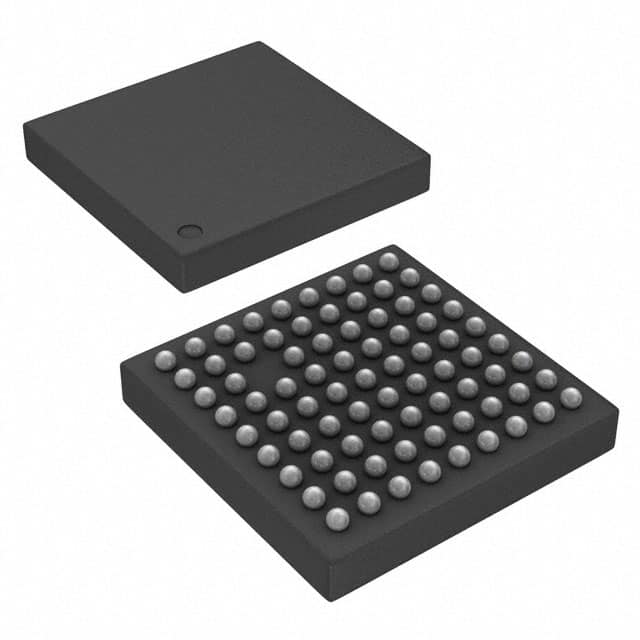MSP430F5513IZQER
Product Overview
- Category: Microcontroller
- Use: Embedded systems, Internet of Things (IoT) devices, and other applications requiring low power consumption and high performance.
- Characteristics:
- Low power consumption
- High performance
- Integrated peripherals
- Flexible clocking options
- Wide operating voltage range
- Package: LQFP (Low-profile Quad Flat Package)
- Essence: The MSP430F5513IZQER is a microcontroller designed for low-power applications with integrated peripherals and flexible clocking options.
- Packaging/Quantity: Available in tape and reel packaging, quantity depends on the supplier.
Specifications
- CPU: 16-bit RISC architecture
- Clock Speed: Up to 25 MHz
- Flash Memory: 32 KB
- RAM: 1.5 KB
- Operating Voltage Range: 1.8V to 3.6V
- Digital I/O Pins: 48
- Analog Inputs: 16
- Communication Interfaces: UART, SPI, I2C
- Timers: 4x 16-bit timers
- ADC: 10-bit SAR ADC with 8 channels
- PWM: 1x 16-bit Timer/PWM module
- Operating Temperature Range: -40°C to +85°C
Detailed Pin Configuration
The MSP430F5513IZQER has a total of 64 pins. Here is a brief overview of the pin configuration:
- VCC: Power supply input
- GND: Ground
- XT1, XT2: External crystal oscillator inputs
- P1.x: General-purpose digital I/O pins
- P2.x: General-purpose digital I/O pins
- P3.x: General-purpose digital I/O pins
- P4.x: General-purpose digital I/O pins
- P5.x: General-purpose digital I/O pins
- P6.x: General-purpose digital I/O pins
- A0-A7: Analog input pins
- UCA0/UCA1: Universal asynchronous receiver/transmitter (UART) pins
- UCB0/UCB1: Serial peripheral interface (SPI) pins
- USCIA0/USCIA1: Inter-integrated circuit (I2C) pins
- TA0-TA3: Timer/counters
- ADC12: Analog-to-digital converter pins
- TB0: Timer/PWM module pin
For a detailed pin configuration diagram, refer to the MSP430F5513IZQER datasheet.
Functional Features
The MSP430F5513IZQER offers several functional features that make it suitable for various applications:
- Low power consumption: The microcontroller is designed to operate at low power levels, making it ideal for battery-powered devices.
- Integrated peripherals: It includes UART, SPI, and I2C interfaces, allowing easy communication with other devices.
- Flexible clocking options: The device supports multiple clock sources and can be configured to operate at different frequencies.
- Wide operating voltage range: It can operate within a wide voltage range, providing flexibility in different power supply scenarios.
Advantages and Disadvantages
Advantages: - Low power consumption enables longer battery life. - Integrated peripherals simplify system design and reduce external component count. - Flexible clocking options allow optimization for different application requirements. - Wide operating voltage range provides versatility in power supply options.
Disadvantages: - Limited flash memory and RAM compared to some other microcontrollers in the same category. - Limited number of digital I/O pins may restrict the complexity of certain projects.
Working Principles
The MSP430F5513IZQER operates based on a 16-bit RISC architecture. It executes instructions fetched from its flash memory and stores data in its RAM. The microcontroller can communicate with external devices through its integrated peripherals, such as UART, SPI, and I2C interfaces. It can also generate PWM signals using its Timer/PWM module.
The device operates at low power levels by utilizing various power-saving modes and clock gating techniques. This makes it suitable for applications where power consumption is critical, such as battery-powered devices and IoT applications.
Detailed Application Field Plans
The MSP430F5513IZQER can be used in a wide range of applications, including but not limited to:
- Home automation systems
- Wearable devices
- Industrial control systems
- Sensor networks
- Medical devices
- Smart agriculture systems
- Energy management systems
Its low power consumption, integrated peripherals, and flexible clocking options make it suitable for these applications, where performance, power efficiency, and communication capabilities are essential.
Detailed and Complete Alternative Models
- MSP430F5529IZQER: Similar to MSP430F5513IZQER but with increased flash memory (128 KB) and RAM (8 KB).
- MSP
Senaraikan 10 soalan dan jawapan biasa yang berkaitan dengan aplikasi MSP430F5513IZQER dalam penyelesaian teknikal
Sure! Here are 10 common questions and answers related to the application of MSP430F5513IZQER in technical solutions:
Question: What is MSP430F5513IZQER?
Answer: MSP430F5513IZQER is a microcontroller from Texas Instruments' MSP430 family, specifically designed for low-power applications.Question: What are the key features of MSP430F5513IZQER?
Answer: Some key features of MSP430F5513IZQER include a 16-bit RISC architecture, 32KB flash memory, 512B RAM, multiple communication interfaces, and low power consumption.Question: What are the typical applications of MSP430F5513IZQER?
Answer: MSP430F5513IZQER is commonly used in applications such as industrial control systems, home automation, sensor networks, portable medical devices, and battery-powered devices.Question: How can I program MSP430F5513IZQER?
Answer: MSP430F5513IZQER can be programmed using various development tools such as Code Composer Studio (CCS), Energia IDE, or third-party compilers like IAR Embedded Workbench.Question: Can MSP430F5513IZQER communicate with other devices?
Answer: Yes, MSP430F5513IZQER supports multiple communication interfaces including UART, SPI, and I2C, allowing it to communicate with other devices such as sensors, displays, and wireless modules.Question: How much power does MSP430F5513IZQER consume?
Answer: MSP430F5513IZQER is known for its low power consumption. In active mode, it typically consumes around 200µA/MHz, and in standby mode, it can consume as low as 0.1µA.Question: Can I use MSP430F5513IZQER in battery-powered applications?
Answer: Yes, MSP430F5513IZQER is well-suited for battery-powered applications due to its low power consumption and various power-saving modes.Question: Does MSP430F5513IZQER have built-in analog-to-digital converters (ADC)?
Answer: Yes, MSP430F5513IZQER has a built-in 12-bit ADC, allowing it to interface with analog sensors and convert analog signals into digital values.Question: Is MSP430F5513IZQER suitable for real-time applications?
Answer: Yes, MSP430F5513IZQER can be used in real-time applications as it supports interrupt-based programming and has a fast wake-up time from low-power modes.Question: Are there any development boards available for MSP430F5513IZQER?
Answer: Yes, Texas Instruments offers various development boards like the MSP-EXP430F5529LP LaunchPad, which can be used for prototyping and evaluating MSP430F5513IZQER-based solutions.
Please note that these questions and answers are general and may vary depending on specific requirements and application scenarios.


